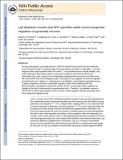Lpd depletion reveals that SRF specifies radial versus tangential migration of pyramidal neurons
Author(s)
Pinheiro, Elaine M.; Xie, Zhigang; Norovich, Amy L.; Vidaki, Marina; Tsai, Li-Huei; Gertler, Frank; ... Show more Show less
DownloadTsai-Lpd depletion reveals.pdf (2.317Mb)
PUBLISHER_POLICY
Publisher Policy
Article is made available in accordance with the publisher's policy and may be subject to US copyright law. Please refer to the publisher's site for terms of use.
Terms of use
Metadata
Show full item recordAbstract
During corticogenesis, pyramidal neurons (~80% of cortical neurons) arise from the ventricular zone, pass through a multipolar stage to become bipolar and attach to radial glia[superscript 1, 2], and then migrate to their proper position within the cortex[superscript 1, 3]. As pyramidal neurons migrate radially, they remain attached to their glial substrate as they pass through the subventricular and intermediate zones, regions rich in tangentially migrating interneurons and axon fibre tracts. We examined the role of lamellipodin (Lpd), a homologue of a key regulator of neuronal migration and polarization in Caenorhabditis elegans, in corticogenesis. Lpd depletion caused bipolar pyramidal neurons to adopt a tangential, rather than radial-glial, migration mode without affecting cell fate. Mechanistically, Lpd depletion reduced the activity of SRF, a transcription factor regulated by changes in the ratio of polymerized to unpolymerized actin. Therefore, Lpd depletion exposes a role for SRF in directing pyramidal neurons to select a radial migration pathway along glia rather than a tangential migration mode.
Date issued
2011-07Department
Massachusetts Institute of Technology. Department of Biology; Picower Institute for Learning and Memory; Koch Institute for Integrative Cancer Research at MITJournal
Nature Cell Biology
Publisher
Nature Publishing Group
Citation
Pinheiro, Elaine M. et al. “Lpd Depletion Reveals That SRF Specifies Radial Versus Tangential Migration of Pyramidal Neurons.” Nature Cell Biology 13.8 (2011): 989–995. Web. 27 June 2012.
Version: Author's final manuscript
ISSN
1465-7392
1476-4679